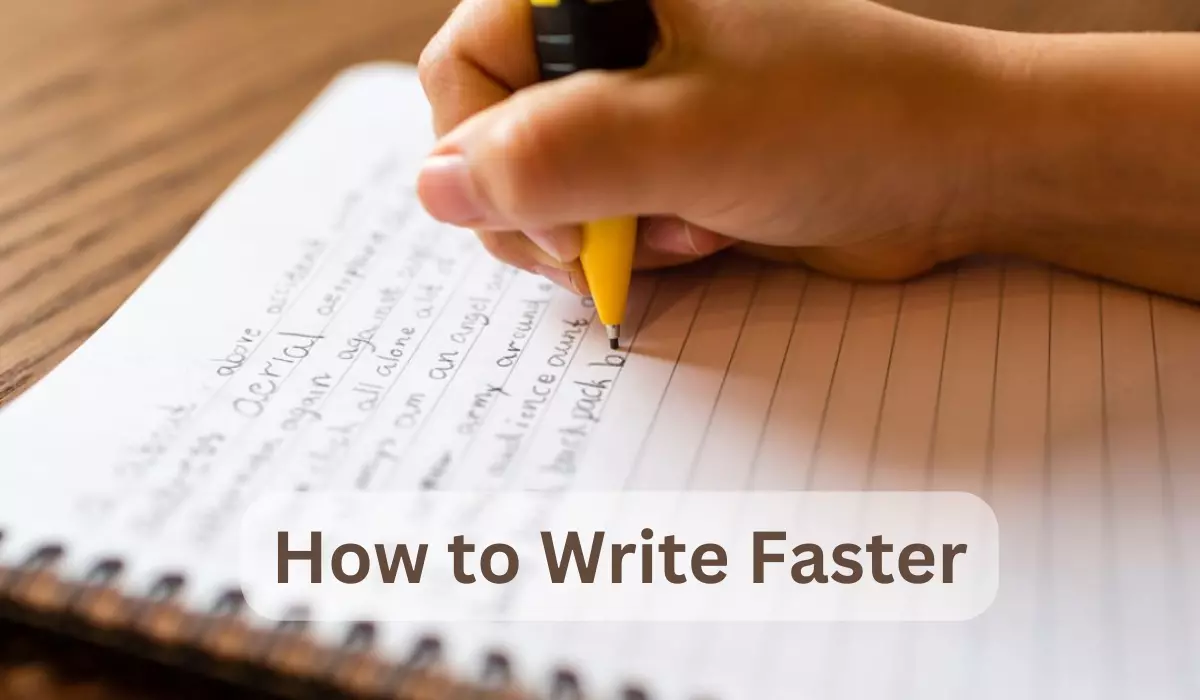Some of the tips on how to write faster are conventional, such as practicing every day, minimizing distractions, planning your writing, using a ballpen, etc. These are great tips but are general in nature. Writing fast becomes useful and necessary in high-pressure situations, such as writing for college exams or assignments.
College assignments and exams are time-bound tasks and inherently full of pressure. In such situations, we might have to choose speed over quality. The fundamental advice is to train yourself for speed rather than stressing over the quality of writing.
In college assignments or exams, the aim is to prove our understanding of the study materials rather than showing off our writing quality.
In this article, we will discuss the top 10 tips for writing faster in time-bound tasks. We will cover some conventional tips like practicing every day, minimizing distractions, being focused, and unconventional tips like choosing speed and overlooking quality to a certain extent. Let’s dive in.
In our exploration of ‘Learn how to write faster in 10 simple steps,’ we’ll also uncover the power of mnemonic techniques for studying, aiding in quicker retention and application of information.
10 Practical Tips to Double Your Writing Speed
Enhancing your handwriting speed can significantly boost your productivity. Discover these ten practical tips, from choosing the right writing implement to perfecting your technique, to help you double your handwriting speed and write with ease.
1. Practice word sprints
Word sprints, involving brief, focused writing bursts, are a valuable tool for building efficient writing habits. By gradually extending the duration of these sessions, your ability to write quickly and maintain concentration can improve significantly.
Writing skills or typing skills can be especially beneficial for college assignments and papers, where time management and productivity are crucial. Cultivating a regular practice of word sprints fosters a healthy writing habit that enhances your overall academic performance and can save time significantly.
2. Make your text clear and easy to understand

Make your assignment or paper clear and easy to understand for the teacher as a student. You don’t have to use impressive vocabulary or grammar to impress your teacher. The purpose of the assignments and papers is to show your understanding of the study material.
If you write using simple and easy vocabulary and grammar, then you will be able to do it faster. At the same time, you will make it easy for your teacher to follow the logic of your text.
3. Know the grammar well
Knowing the grammar will allow you to skip checking for simple mistakes. This tip saves you a lot of time for your writing project, as you don’t have to double-check your sentence structures and simple grammar rules. You will have to edit your paper less often and can quickly start writing the next segment.
4. Minimize distractions
Minimizing distractions will improve your focus while writing, which, in turn, saves you a lot of while writing. Distractions can divert your focus and waste a lot of time, thus reducing your productivity.
After minimizing distractions, you will save time and produce more texts in a shorter span of time. To reduce distractions, you can sit in a quiet place, keep your digital devices aside and far away from your reach, use noise-cancellation headphones, or play soothing music that lets you focus on the writing task.
5. Prepare your research before writing
Prepare your research before writing to avoid thinking about what to write next. Having done your research beforehand will give you the material to write. Otherwise, you might need more time to think and plan what to write while sitting at the desk.
Read the necessary textbooks, surf the internet, and plan your assignment or paper before starting writing. This will reduce the amount of writing time you waste gazing at a blank page trying to remember what you intended to say and how you intended to express it.
Enhancing self-discipline for students is crucial in achieving academic goals, as it fosters consistent study habits and effective time management, ultimately leading to academic success.
6. Use Pomodoro Technique
The Pomodoro Technique is a technique way to write faster without feeling overwhelmed. According to this technique, you write for 25 minutes with unwavering focus and then take a short break of 5 min. After that, you write for 25 minutes with complete focus.
This technique can save you from writer’s block, thus wasting less time and producing more texts in a limited time.
7. Create an outline
Creating an outline can speed up the writing process as it gets you out of the thinking stage. A detailed outline will guide you on what to write next, thus saving more time and producing more text output in a limited amount of time given to you.
Accompanied with the research you did before, this can save you a lot of time and increase your overall writing efficiency.
8. Keep a timer

Keeping a timer will create an urgency within you, thus speeding up the writing process. Many writers, especially those engaged in academic writing, often find that they can write most effectively when facing a looming finish line.
When keeping a timer, you will be aware of the amount of time left. It will keep you in reality and won’t allow you to divert your focus to unnecessary thoughts or things.
Using a timer will force you to write quickly and finish the assignment as fast as possible. Not only can you track your progress as you meet new writing challenges, but you can also gain a sense of accomplishment and confidence in your abilities.
9. Set a realistic goal.
Setting a realistic goal can allow you to write faster to achieve the goal. You have a higher probability of finishing the writing tasks if you give yourself 1 hour to finish writing your college paper than with no definite goal in mind.
Goals encourage writing quickly and reaching the target. Scientific studies have proven that setting goals can motivate us and increase our chances of achieving them.
10. Have a good sitting posture
Sitting in a comfortable and healthy way can improve your writing speed as it minimizes the distractions in the body. Good posture can have a substantial impact on your focus and ability to be efficient.
A good sitting posture includes a straight back resting on the back of the chair, feet on the floor, elbows resting on the desk, and forming right angles with the desk. A bad sitting posture can make you tired and less focused on your task, thus wasting a lot of time unnecessarily.
Bonus tip
Overthinking while writing can slow you down. Here’s a helpful technique: take a brief moment to visualize your response before you start.
Imagine the scene like a movie in your mind—immerse yourself in the details. Think about the key points, arguments, or ideas you want to convey. Once your narrative is clear in your imagination, start writing. This approach will not only help you write faster but also infuse your work with enthusiasm and clarity, making your exam or class writing more effective.
As students seek strategies to excel academically, valuable insights into mastering in-class essay exams can make a significant difference, providing practical tips for writing essay the challenges of timed writing assessments.
How to Choose the Right Pen for Your Fast Writing Needs?

When choosing a pen for faster handwriting, you can consider pens that:
- Evaluate Balance: Ensure the pen is well-balanced without excessive weight at one end.
- Opt for Low Friction Tips: Look for pens with minimal friction at the point of contact with paper to enable smooth ink flow.
- Consider Nib/Writing Point Size: Choose thinner tips (around 0.7mm to 0.9mm) for faster writing, especially with smaller letters.
- Check for Fit: Ensure the pen has no loose parts, and the cap closes securely.
- Prefer Fountain or Rollerball Pens: These pens offer a light touch, constant ink flow, and require less pressure for faster writing.
- Seek Glide and Minimal Pressure: Select pens that glide effortlessly and require minimal pressure on paper.
- Explore Pen Types: Depending on your preference, opt for ballpoint, rollerball, or fountain pens, each offering distinct advantages for quicker handwriting.
- Glide Across Paper: Choose pens that smoothly glide across paper to reduce drag and enhance writing speed.
- Require Minimal Pressure: Pick pens that demand minimal pressure, preventing hand fatigue during extended writing sessions.
- Constant Ink Flow: Look for pens with a consistent ink flow to maintain uninterrupted writing and save precious time.
Why do I write so slow?
Writing slowly can be a common challenge for various reasons, especially when you’re balancing academics with other responsibilities. Here are some factors that might contribute to slow writing:
- Limited Practice: If you haven’t been writing regularly, it’s natural to be a bit slower. Writing more often can help improve your speed over time.
- Striving for Perfection: Trying to make every word perfect as you write can slow you down. Remember that it’s okay to make mistakes and refine your work later.
- Fear of Errors: If you’re afraid of making mistakes, you might find yourself writing cautiously and slowly to avoid them.
- Difficulty Staying Focused: College life can be full of distractions. Staying focused on your writing can sometimes be a struggle.
- Grammar and Spelling Challenges: If you’re not confident in your grammar or spelling skills, you may need to pause and check your work frequently.
To improve your writing skills, incorporate regular writing session, set realistic goals, and embrace the learning process by allowing mistakes.
Use timers to maintain focus, seek feedback from trusted sources for valuable insights, and take short breaks to rejuvenate your creativity during challenging moments.
What is the fastest handwriting style?
Cursive handwriting is commonly believed to be faster than print due to its connected letters, reducing the need to lift the pen frequently. Nonetheless, research indicates that when it comes to legibility, cursive writing is not inherently swifter than well-formed printed handwriting.
The optimal combination of speed and legibility is achieved by selectively connecting certain letters rather than all. Additionally, when jotting down drafts or performance notes, angling your writing can also boost writing speed.
Utilizing the resources offered by a college writing center can immensely benefit students, providing personalized guidance, feedback, and support to refine their writing skills and enhance academic performance.
Note-Taking: Handwritten vs. Typed
Research suggests that handwritten notes may enhance material retention and learning by encouraging deeper processing. This approach requires summarizing lecture information into fewer words, activating distinct brain areas.
However, some studies show no significant difference between handwritten and typed notes in quiz performance. The choice between methods depends on individual preferences and specific academic tasks.
Understanding the intricacies of how to write a research paper is fundamental for students embarking on academic endeavors, guiding them through the structured process of research, analysis, and coherent presentation.
Handwritten notes excel in promoting profound comprehension, while typing provides the benefits of legibility and organization. Nevertheless, a swift typing speed remains a valuable asset for your future career endeavors.
Write First, Edit Later

When you’re working on your first draft of an assignment, don’t worry too much about making it perfect right away. Instead, focus on getting your ideas onto the page as quickly as possible. It’s like laying down the foundation of a building before adding all the finishing touches.
Don’t get stuck trying to use fancy or complicated words, and don’t obsess over every detail. That’s what the editing phase is for. During editing, you’ll have the chance to refine your work, improve clarity, and correct any grammar or spelling mistakes.
Comprehending the essential steps of how to write a term paper empowers students with a structured approach, facilitating thorough research, organization, and effective communication of ideas within academic assignments
By separating the writing and editing processes, you’ll likely find it easier to express your thoughts and complete your assignments more efficiently. So, for your first rough draft, just let your ideas flow without the pressure of perfection. Don’t worry; you’ll fix all of those errors throughout the editing process.
Why does reading a piece backwards help to catch more mistakes when proofreading?
Reading backwards helps to catch more mistakes when proofreading because it forces you to slow down and focus on each individual word and punctuation mark.
When you read forwards, your brain is able to automatically fill in the blanks and correct minor errors, but this can lead to you overlooking more serious mistakes. Reading backwards prevents your brain from doing this, which means that you are more likely to notice any errors in the text.
In addition, reading backwards can help you to identify errors that you would not notice when reading forwards.
For example, if you have accidentally typed the wrong word, you may not notice it when reading forwards because your brain is able to make sense of the sentence even if the word is incorrect. However, when you read backwards, you are more likely to notice the error because the word will not make sense in the context of the sentence.
Overall, reading backwards is a simple but effective way to catch more mistakes when proofreading. If you have a few minutes before submitting your work, I encourage you to give it a try.
Final Words on How to Write Faster
Improving your handwriting speed, a skill often neglected after childhood, offers substantial benefits, particularly for university students who frequently rely on handwritten work. Becoming a faster writer may make the difference between a successful assignment and a lengthy, frustrating one that hinders productivity and creativity.
These advantages include reduced mental effort in the act of writing, better alignment between thinking and writing flow, and enhanced performance in academic tasks that involve extensive handwritten work under time constraints.
You now have the top 10 practical writing tips on how to write faster. Some of them might need more practice, like the Pomodoro Technique or writing sprints. However, each of these tips, when followed together, can significantly improve your writing efficiency and speed.
The provided tips and strategies, ranging from immediate fixes to those requiring practice, offer a path to quicker, more efficient handwriting, allowing students to choose what suits them best and experience noticeable speed improvements with minimal effort.
In the pursuit of academic excellence, the practice of meticulously proofreading writing assignments plays a pivotal role, ensuring clarity, coherence, and accuracy in conveying ideas within scholarly work.
Remember, writing is a skill that can be developed over time. With dedication and practice, you can certainly enhance your writing speed and become a more proficient writer while managing your college studies and other commitments.













